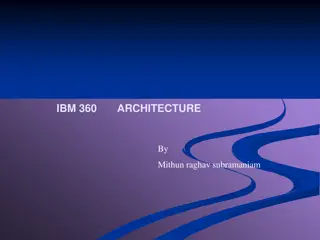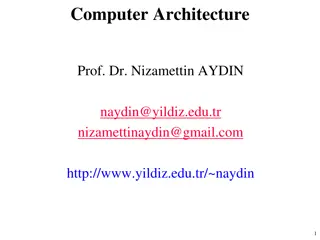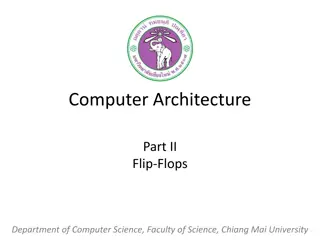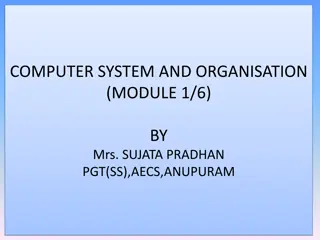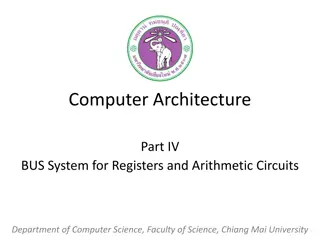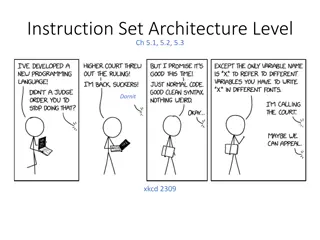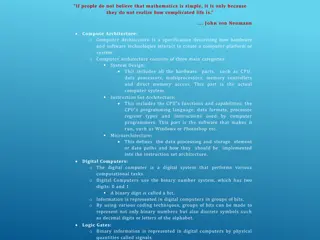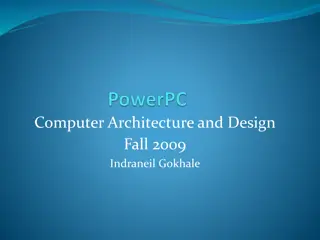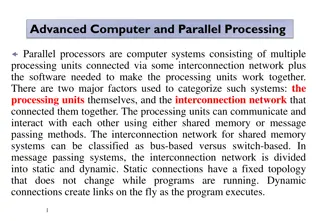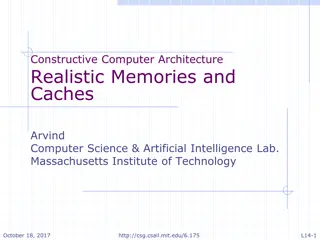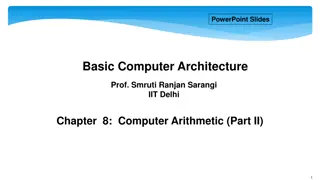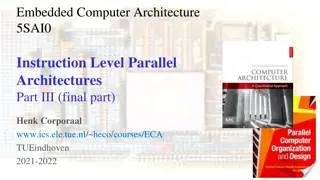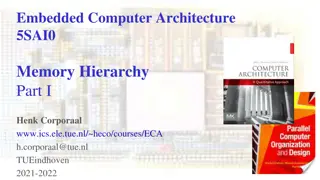Computer Architecture: A Comprehensive Overview by Prof. Dr. Nizamettin AYDIN
Explore the realm of computer architecture through the expertise of Prof. Dr. Nizamettin AYDIN, covering topics like RISC characteristics, major advances in computers, comparison of processors, and the driving force for CISC. Delve into the evolution of processors, register optimization, and the transition from CISC to RISC architectures. Learn about the key features of RISC, the challenges of CISC, and the semantic gap between high-level languages and computer operations.
Download Presentation

Please find below an Image/Link to download the presentation.
The content on the website is provided AS IS for your information and personal use only. It may not be sold, licensed, or shared on other websites without obtaining consent from the author.If you encounter any issues during the download, it is possible that the publisher has removed the file from their server.
You are allowed to download the files provided on this website for personal or commercial use, subject to the condition that they are used lawfully. All files are the property of their respective owners.
The content on the website is provided AS IS for your information and personal use only. It may not be sold, licensed, or shared on other websites without obtaining consent from the author.
E N D
Presentation Transcript
Computer Architecture Prof. Dr. Nizamettin AYDIN naydin@yildiz.edu.tr nizamettinaydin@gmail.com http://www.yildiz.edu.tr/~naydin 1
Computer Architecture RISC Characteristics 2
Outline Major Advances in Computers Comparison of processors Driving force for CISC Execution Characteristics Large Register File Registers for Local Variables Global Variables Compiler Based Register Optimization Graph Coloring Register Optimization RISC Characteristics RISC Pipelining 3
Major Advances in Computers The family concept IBM System/360 1964 DEC PDP-8 Separates architecture from implementation Microporgrammed control unit Idea by Wilkes 1951 Produced by IBM S/360 1964 Cache memory IBM S/360 model 85 1969 Solid State RAM Microprocessors Intel 4004 1971 Pipelining Introduces parallelism into fetch execute cycle Multiple processors 4
RISC Reduced Instruction Set Computer (RISC) Key features Large number of general purpose registers And/or use of compiler technology to optimize register usage Limited and simple instruction set Emphasis on optimising the instruction pipeline 5
Driving force for CISC Complex Instruction Set Computer (CISC) Software costs far exceed hardware costs Increasingly complex high level languages Major cost in the lifecycle of a system is software, not hardware Systems have also an element of unreliability It is common for programs, both system and application, to continue to exhibit new bugs after years of operation Response from researchers and industry has been to develop ever more powerful and complex high-level programming languages HLLs allow programmers to express algorithms more concisely 7
Driving force for CISC This solution gave rise to another problem: Semantic gap, which is... difference between the operations provided in HLLs and those provided in computer architecture Symptoms of this gap: Execution ineficiency Excessive machine program size Compiler complexity Processor designers response: Architectures intended to close this gap, such as... Large instruction sets More addressing modes Hardware implementations of HLL statements e.g. CASE (switch) on VAX 8
Intention of CISC Complex instruction sets are intended to... Ease the task of compiler writer Improve execution efficiency Complex operations can be implemented in microcode Provide support for more complex HLLs 9
Execution Characteristics Studies have been done over the years to determine the characteristics and patterns of execution of machine instructions generated from HLL programs The results of these studies inspired some researchers to look for a different approach: To make the architecture that supports the HLL simpler, rather than more complex The aspects of computation of interest are as follows: Operations performed Determine the functions to be performed by the processor and its interaction with memory Operands used Determine the memory organization for storing them and the addressing modes for accessing them Execution sequencing Determines the control and pipeline organization 10
Relative Dynamic Frequency of HLL Operations A variety of studies have been done to analyze the behavior of HLL programs. Dynamic studies are measured during the execution of the program The table indicates the relative significance of various statement types in an HLL Dynamic Occurrence Machine- Instruction Weighted Pascal Memory- Reference Weighted Pascal Assignments Movement of data Conditional statements (IF, LOOP) Sequence control Procedure call-return is very time consuming Depends on number of parameters passed Depends on level of nesting Pascal C C C ASSIGN 45% 38% 13% 13% 14% 15% LOOP 5% 3% 42% 32% 33% 26% CALL 15% 12% 31% 33% 44% 45% IF 29% 43% 11% 21% 7% 13% GOTO 3% OTHER 6% 1% 3% 1% 2% 1% Some HLL instruction lead to many machine code operations 11
Operands Table shows dynamic percentage of operands Pascal C Average Integer Constant 16% 23% 20% Scalar Variable 58% 53% 55% Array/Structure 26% 24% 25% Mainly local scalar variables Optimisation should concentrate on accessing local variables 12
Implications Best support is given by optimising most used and most time consuming features Large number of registers Operand referencing Careful design of pipelines Branch prediction etc. Simplified (reduced) instruction set 13
Large Register File Software solution Require compiler to allocate registers Allocate based on most used variables in a given time Requires sophisticated program analysis Hardware solution Have more registers Thus more variables will be in registers 14
Registers for Local Variables Store local scalar variables in registers Reduces memory access Every procedure (function) call changes locality Parameters must be passed Results must be returned Variables from calling programs must be restored 15
Global Variables There are two options for storing variables declared as global in an HLL: Allocated by the compiler to memory Instructions will use memory-reference operands Inefficient for frequently accessed variables Have a set of registers for global variables Fixed in number Available to all procedures Increased hardware burden Compiler must decide which global variables should be assigned to registers 16
Registers v Cache Large Register File Cache All local scalars Recently-used local scalars Individual variables Blocks of memory Compiler-assigned global variables Recently-used global variables Save/Restore based on procedure nesting depth Save/Restore based on cache replacement algorithm Register addressing Memory addressing Adressing overhead Large based register file is superior 17
Compiler Based Register Optimization Assume small number of registers (16-32) Optimized register usage is the responsibility of the compiler HLL programs have no explicit references to registers The objective of compiler is to keep the operands for as many computations as possible in registers to minimize load-and-store operations Following approach is taken: Assign symbolic or virtual register to each candidate variable Compiler maps (unlimited) symbolic registers to a fix number of real registers Symbolic registers that do not overlap can share the same real registers If you run out of real registers some variables use memory 18
Graph Coloring The essence of the optimization task is to decide which quantities are to be assigned to registers at any given point in the program The technique commonly used in RISC compilers is known as graph coloring: Given a graph of nodes and edges Assign a color to each node such that... Adjacent nodes have different colors Use minimum number of colors Graph coloring is adapted to the compiler problem as follows: Nodes of the graph are symbolic registers Two registers that are live in the same program fragment are joined by an edge Try to color the graph with n colors, where n is the number of real registers Nodes that share the same color can be assigned to the same register Nodes that can not be colored are placed in memory 19
Graph Coloring Approach Assume a program with 6 symbolic registers to be compiled into 3 actual registers A possible coloring with 3 colors is indicated. One symbolic register, F, is left uncolored and must be used dealt with using loads and stores 20
Register Optimization There is a trade of between... Use of large set of registers and... Compiler-based register optimization In one study, reported that... With a simple register optimization, there is little benefit to the use of more than 64 registers With reasonably sofisticated register optimization techniques, there is only marginal performance improvement with more than 32 registers 21
Why CISC (1)? Two principle reasons: Compiler simplification? Disputed Complex machine instructions harder to exploit Optimization more difficult Smaller programs? Program takes up less memory but Memory is now cheap May not occupy less bits, just look shorter in symbolic form More instructions require longer op-codes Register references require fewer bits 22
Why CISC (2)? Faster programs? Bias towards use of simpler instructions More complex control unit Microprogram control store larger thus simple instructions take longer to execute It is far from clear that CISC is the appropriate solution 23
RISC Characteristics Common characteristics of RISC are: One instruction per cycle Register to register operations Few, simple addressing modes Few, simple instruction formats Hardwired design (no microcode) Fixed instruction format More compile time/effort 24
RISC v CISC Not clear cut Many designs borrow from both philosophies More recent RISC designs are no longer pure RISC More recent CISC designs are no longer pure CISC e.g. PowerPC and Pentium II 25
RISC Pipelining Most instructions are register to register An instruction cycle has two phases of execution: I: Instruction fetch E: Execute Performs an ALU operation with register input and output For load and store operations, there are three stages: I: Instruction fetch E: Execute Calculates memory address D: Memory Register to memory or memory to register operation 26
Sequential execution Timing of a sequence of instructions with... No pipelining This is a wasteful process 27
Pipelined timing - I This is a... Two stage pipelining Provides upto twice the execution rate of a serial scheme I and E stages of two different instructions are performed simultaneously Two main problems: Only one memory access per stage Assuming that single port main memory is used Branch instruction interrupts the sequencial flow of execution NOOP is inserted by compiler or assembler for minimum circuitry 28
Pipelined timing - II Pipelining can be improved by... permitting two memory access per stage Upto three instructions can be overlapped, prividing... An improvement as much as a factor of 3. Branch instruction interrupts the sequencial flow of execution NOOP is inserted by compiler or assembler for minimum circuitry 29
Pipelined timing - III Because E stage involves ALU operation, it may be longer. Threfore E stage... can be devided into two substages E1 : register file read E2 : ALU operation and register write... This results in a ... four stage pipeline Maximum speed up of a factor of 4 30
Optimization of Pipelining Pipelining in RISC is efficient. The reason for this is that... RISC instructions are simple and regular However branch dependencies reduce the overall execution rate To compensate for these dependencies ... some code recognition techniques have been developed Delayed branch Does not take effect until after execution of following instruction This following instruction is the delay slot Illustrated in next slide 31
Normal and Delayed Branch Address Normal Branch Delayed Branch Optimized Delayed Branch 100 LOADX, rA LOADX, rA LOADX, rA 101 ADD 1, rA ADD 1, rA JUMP 105 102 JUMP 105 JUMP 106 ADD 1, rA 103 ADD rA, rB NOOP ADD rA, rB 104 SUB rC, rB ADD rA, rB SUB rC, rB 105 STORE rA, Z SUB rC, rB STORE rA, Z 106 STORE rA, Z 32
Traditional pipeline JUMP instruction is fetched at time 4. At time 5, JUMP is executed and ADD is fetched However, pipeline must be cleared of instruction 103 because of JUMP instruction At time 6, instruction 105 is loaded There must be a special circuitry to clear pipeline in branch instructions 33
RISC pipeline with inserted NOOP Because a NOOP inserted, there is no need for special circuitry to clear pipeline NOOP executes with no effect 34
Reversed instructions JUMP is fetched at time 2, before the ADD instruction However, ADD is fetched before JUMP is executed At time 4, ADD is executed at the same time that instruction 105 is fetched 35
Controversy Quantitative compare program sizes and execution speeds Qualitative examine issues of high level language support and use of VLSI real estate Problems No pair of RISC and CISC that are directly comparable No definitive set of test programs Difficult to separate hardware effects from complier effects Most comparisons done on toy rather than production machines Most commercial devices are a mixture 37
MIPS R4000 1st commercial RISC chip developed by MIPS Technology inch MIPS R2000 and R3000, are 32 bit RISC processors MIPS R4000 is 64 bit processor R4000 is partitioned into two sections: One contains CPU The other contains the coprocessor for memory management 32 64 bit registers Upto 128 Kbytes of high-speed cache 38
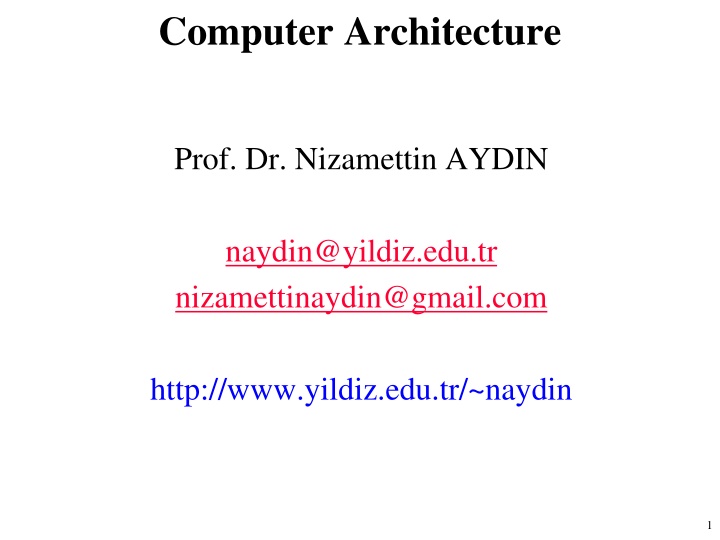

![❤Book⚡[PDF]✔ The Apollo Guidance Computer: Architecture and Operation (Springer](/thumb/21611/book-pdf-the-apollo-guidance-computer-architecture-and-operation-springer.jpg)


